Reaching the Summit
LBJ Library director Mark Updegrove takes us behind the scenes of a historic gathering of American presidents at UT.
The first time a sitting president came to the Lyndon Baines Johnson Presidential Library was on May 21, 1971, when Richard Nixon boarded Air Force One and journeyed to the campus of the University of Texas at Austin to help former President Johnson dedicate his library to the American people.
It had been a little more than two years since LBJ yielded the Oval Office to Nixon, and his place in history was very much in the balance. The war in Vietnam that LBJ had escalated and that continued to divide the nation, hung balefully over his legacy. This, despite the profusion of landmark laws he left in his wake, including the passage of a triumvirate of seminal civil rights legislation: the 1964 Civil Rights Act, the 1965 Voting Rights Act, and the 1968 Fair Housing Act. As the library’s inauguration played out, the voices of 2,100 Vietnam protesters rumbled in the distance, their chants of “No more war!” carried by 25 mph winds that swirled throughout the day.
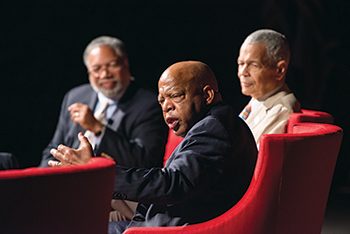
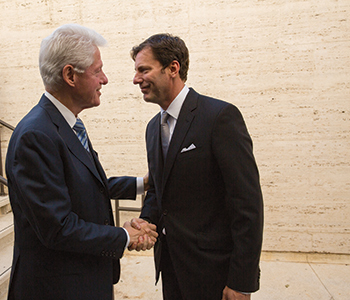
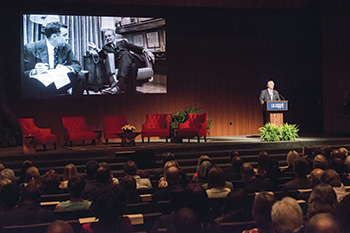 On
On 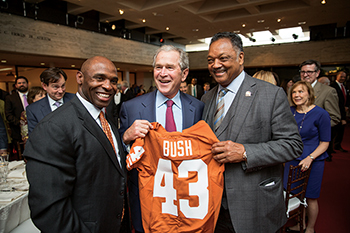 April 10, 2014, when Barack Obama became the second sitting president to visit, the weather—which topped out at 88 degrees—was far less tempestuous, and LBJ’s legacy had become far clearer.
April 10, 2014, when Barack Obama became the second sitting president to visit, the weather—which topped out at 88 degrees—was far less tempestuous, and LBJ’s legacy had become far clearer.
Obama came to the library, along with former presidents Carter, Clinton, and George W. Bush, to take part in the Civil Rights Summit, a three-day conference commemorating the 50th anniversary of the Civil Rights Act, which outlawed discrimination on the basis of race, color, creed, or gender. (George H.W. Bush, one of the event’s honorary co-chairs, was unable to attend.) Their participation spoke to the importance of civil rights in our country’s long, troubled journey toward fulfilling the promise in the Declaration of Independence: “We hold these truths to be self-evident, that all men are created equal.” It also marked a growing appreciation for what has become the bigger part of LBJ’s legacy, as each of the presidents paid tribute to his courage and conviction in the fight for civil rights.
A temporary exhibit at the library featured the “Cornerstones of Civil Rights,” linking the civil rights bequests of LBJ and Abraham Lincoln. One case held a copy of the Emancipation Proclamation and the proposal for the 13th Amendment to the Constitution banning slavery, both signed by Lincoln, and the 1964 Civil Rights Act and 1965 Voting Rights Act, both signed by LBJ. Beside them were Lincoln’s iconic stovepipe hat and LBJ’s Resistol cowboy hat, which he often wore at his ranch, known as the “Texas White House.”


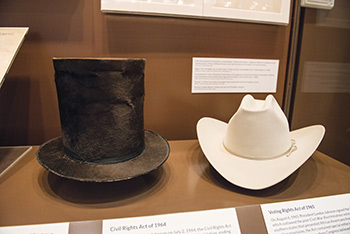
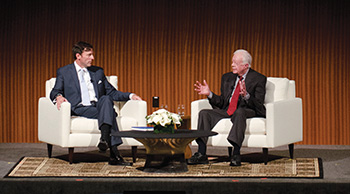 The summit celebrated not only America’s progress on civil rights in the 50 years since the Act was signed, but also addressed the civil rights issues of our times. LBJ would have wanted it that way. As he said during his administration, “We are not caretakers of the past, but are charged with the construction of tomorrow.”
The summit celebrated not only America’s progress on civil rights in the 50 years since the Act was signed, but also addressed the civil rights issues of our times. LBJ would have wanted it that way. As he said during his administration, “We are not caretakers of the past, but are charged with the construction of tomorrow.”
In that spirit, heroes of the civil rights movement, like Julian Bond, John Lewis, and Andrew Young, shared the stage with those who, along with them, are making a difference in the 21st century. Prior to Obama’s keynote address, Grammy Award winner Mavis Staples sang “We Shall Overcome,” the anthem of the civil rights movement, with a resonance that suggested there are still struggles in our midst. The summit’s proceedings shed light on them: Former legal rivals Ted Olson and David Boies reflected on why they joined forces to mount a Supreme Court challenge against Proposition 8, a ballot initiative that would have banned gay marriage in California; George W. Bush’s Secretary of Education, Margaret Spellings, and Democratic Congressman George Miller talked about their efforts toward the passage of the No Child Left Behind Act; and sports legends Jim Brown and Bill Russell discussed race in the 1960s when they dominated their sports—football and basketball respectively—and the issues athletes face today.
I have been asked a number of times since the summit what personal memory from its lustrous three days burns the brightest. There are many. But the most prominent is of sitting on the stage of the LBJ Auditorium with John Lewis and Michelle Obama to my immediate right, watching President Obama address a rapt audience of nearly a thousand, as he said:
“You’re reminded daily that in this great democracy, you are but a relay swimmer in the currents of history, bound by decisions made by those who came before, reliant on the efforts of those who will follow to fully vindicate your vision. But the presidency also affords a unique opportunity to bend those currents by shaping our laws and by shaping our debates, by working within the confines of the world as it is but also by reimagining the world as it should be.”
LBJ could have said it no better. And surely he would have been proud of the recognition that his efforts a half a century ago bent the currents of history by imagining our nation as it should be.
From top: Lonnie G. Bunch III, John Lewis, and Julian Bond; President Bill Clinton and Mark Updegrove; Tom Johnson; Charlie Strong, President George W. Bush, and Rev. Jesse Jackson; Mavis Staples sings “We Shall Overcome”; Bernice A. King, CEO of the King Center; “Cornerstores of Civil Rights” exhibit on display; Updegrove talks with President Jimmy Carter.
Photos by Marsha Miller, Lauren Gerson, David Hume Kennerly, and Eric Draper.







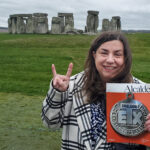









2 Comments